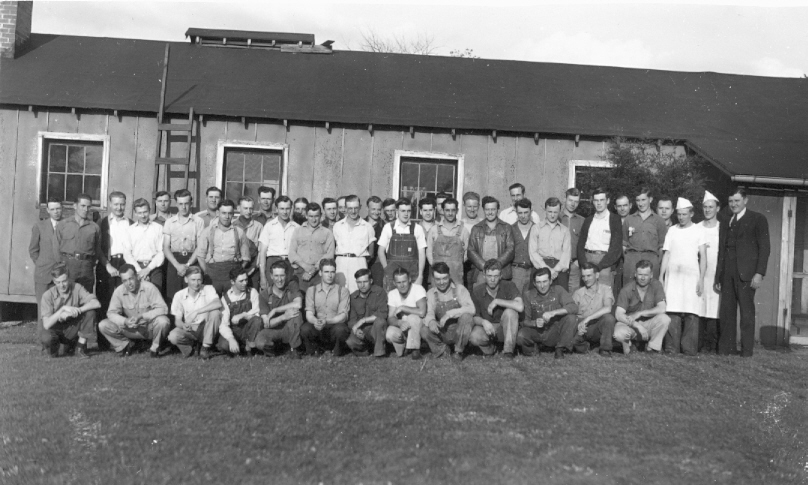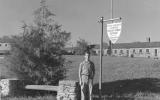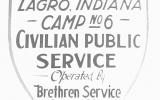CPS Unit Number 006-01
Camp: 6
Unit ID: 1
Operating agency: BSC
Opened: 5 1941
Closed: 11 1944
Workers
Total number of workers who worked in this camp: 330
-
 CPS Camp # 6, Lagro, IndianaBase camp viewDigital Image © 2011 Brethren Historical Library and Archives. All Rights Reserved.
CPS Camp # 6, Lagro, IndianaBase camp viewDigital Image © 2011 Brethren Historical Library and Archives. All Rights Reserved. -
 CPS Camp # 6, Lagro, IndianaA class in transportation and communications in China; Howard Sollenberger, leader.Digital Image © 2011 Brethren Historical Library and Archives. All Rights Reserved.
CPS Camp # 6, Lagro, IndianaA class in transportation and communications in China; Howard Sollenberger, leader.Digital Image © 2011 Brethren Historical Library and Archives. All Rights Reserved. -
 CPS Camp # 6, Lagro, IndianaPaul Bowman, director.Digital Image © 2011 Brethren Historical Library and Archives. All Rights Reserved.
CPS Camp # 6, Lagro, IndianaPaul Bowman, director.Digital Image © 2011 Brethren Historical Library and Archives. All Rights Reserved. -
 CPS Camp # 6, Lagro, IndianaJefferson Mathis, director, on far right.Digital Image © 2011 Brethren Historical Library and Archives. All Rights Reserved.
CPS Camp # 6, Lagro, IndianaJefferson Mathis, director, on far right.Digital Image © 2011 Brethren Historical Library and Archives. All Rights Reserved. -
 CPS Camp # 6Lagro, Indiana.Digital Image © 2011 Brethren Historical Library and Archives. All Rights Reserved.
CPS Camp # 6Lagro, Indiana.Digital Image © 2011 Brethren Historical Library and Archives. All Rights Reserved.
CPS Camp No. 6, a Soil Conservation Service base camp located in Lagro, Indiana and operated by the Brethren Service Committee, opened in 1941 and closed in November 1944. Men worked in two areas: soil conservation and developing the Salamonie River and Francis Slocum state forests.
Directors: Clyde Forney, Paul Bowman, Jr., J. H. Mathis, Glen Stinebaugh
The first ten men assigned to Brethren CPS were Jesse E. Clem, Ora E. Hahnert, John M. Lantis, Loren K. Moser, Harold Phend, Forest W. Shively, Arthur J. Thomas, Bernard W. Vaughn, Charles A. Wagner, and E. L. Zollers. Nine of the men entered from Indiana and one from Pennsylvania. Of the ten, five reported their denominational affiliation when entering CPS as Brethren, and one each reported Church of Christ, Church of God, Mennonite, Methodist, and OId German Baptist.
On average, men in Brethren camps reported 12.22 years of education upon entry into CPS. Twelve percent of men in Brethren camps reported their occupation when entering CPS as students; twenty nine percent as farmers or other agricultural workers; eighteen percent as technical or professional work; sixteen percent as business management, sales and public administration; twenty one percent as skilled and semi-skilled trades; and four percent as factory and other work. (Sibley and Jacob pp. 171-72)
This first unit to receive Brethren campers had two emphases: soil conservation and developing the Salamonie River and Francis Slocum state forests. Soil conservation occurred on nearby farms where owners were cooperating with the government program. Men constructed fence, performed gully control, terracing, ditching, tilling, timber stand improvement, and tree planting. Base camp work was best described as manual, outdoor and of an unskilled or semi-skilled nature.
At Lagro men volunteered to perform emergency farm labor on their own time to assist families around the camp whose men were at war. Lagro was one of the first camps to permit this arrangement. The camp contributed all off-duty earnings from this effort to the Wabash County Hospital for the purchase of a combined respirator and inhalator. (Eisan p. 172; Robinson)
The education program in the base camps tended to focus on the men’s subject matter interests. While the camps overall focused on education for postwar reconstruction and relief, other courses garnered interest in the areas of pacifism, Bible study, skills acquisition and cooperative living.
The first Brethren CPS unit established for relief and rehabilitation training for men assigned to the China Unit for ambulance and emergency relief work, brought fourteen men from CPS camps to Camp Lagro. The men studied Chinese language, first aid and elementary medical procedures through a special arrangement with Selective Service that freed them from regular camp work for this study. During the six week period, the men helped pack drugs, medical and surgical supplies. One of the men, Howard Sollenberger, experienced in the China field, taught relief techniques and Dr. Carl Coffman, a medical missionary to China worked with the men. Near the end of the training period the State Department blocked the assignment of passports to CPS men.
Shortly after the refusal, the unit members performed emergency duty at Goshen, Indiana after it had been struck by a tornado. The men worked there for a month, before returning to Lagro. The China Unit was officially disbanded to the disappointment of many in CPS. Eventually some of the fourteen men served in Castañer, Puerto Rico.
The Salmonie Peace Pipe newspaper was published from July 1941 through November 1943. The men published a camp paper Common Ground July through September of 1942, and also Camp Lagro Newsletter with issues in 1941, 1942 and 1943. In 1942 the men also published Louis Whitaker Newsletter.
For more information on work in Brethren camps, see Leslie Eisan, Pathways of Peace: A History of the Civilian Public Service Program Administered by the Brethren Service Committee. Elgin, IL: Brethren Publishing House, 1948, Chapter 3, pp. 75-111; China Unit pp. 315-317.
For more information on Forest Service camps see Albert N. Keim, The CPS Story: An Illustrated History of Civilian Public Service. Intercourse, PA: Good Books 1990.
See information on agricultural labor shortages in Mitchell Lee Robinson. “Civilian Public Service During World War II: The Dilemmas of Conscience and Conscription in a Free Society.” Ph.D. diss., Cornell University, 1990, pp. 128-145.
See also Mulford Q. Sibley and Philip E. Jacob, Conscription of Conscience: The American State and the Conscientious Objector, 1940-1947. Ithaca, NY: Cornell University Press, 1952.
Swarthmore College Peace Collection, Camp periodicals database.




